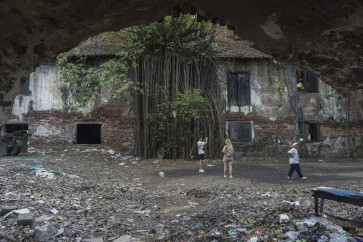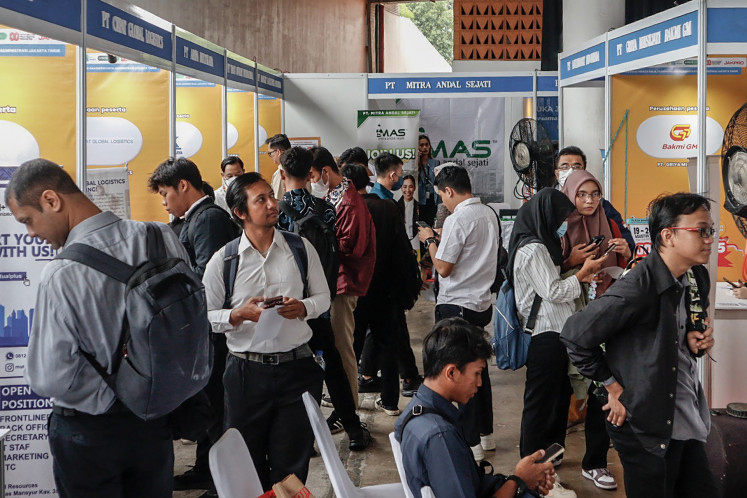Popular Reads
Top Results
Can't find what you're looking for?
View all search resultsPopular Reads
Top Results
Can't find what you're looking for?
View all search resultsThree rural banks shut over fraud
Side by side: Bank Indonesia Governor Agus Martowardojo (left) and Financial Services Authority (OJK) chief commissioner Muliawan Hadad pose after signing a cooperation agreement between the central bank and the OJK on coordinating tasks in Jakarta on Friday
Change text size
Gift Premium Articles
to Anyone
 Side by side: Bank Indonesia Governor Agus Martowardojo (left) and Financial Services Authority (OJK) chief commissioner Muliawan Hadad pose after signing a cooperation agreement between the central bank and the OJK on coordinating tasks in Jakarta on Friday. (JP/R. Berto Wedhatama) (left) and Financial Services Authority (OJK) chief commissioner Muliawan Hadad pose after signing a cooperation agreement between the central bank and the OJK on coordinating tasks in Jakarta on Friday. (JP/R. Berto Wedhatama)
Side by side: Bank Indonesia Governor Agus Martowardojo (left) and Financial Services Authority (OJK) chief commissioner Muliawan Hadad pose after signing a cooperation agreement between the central bank and the OJK on coordinating tasks in Jakarta on Friday. (JP/R. Berto Wedhatama) (left) and Financial Services Authority (OJK) chief commissioner Muliawan Hadad pose after signing a cooperation agreement between the central bank and the OJK on coordinating tasks in Jakarta on Friday. (JP/R. Berto Wedhatama)
S
span class="caption" style="width: 510px;">Side by side: Bank Indonesia Governor Agus Martowardojo (left) and Financial Services Authority (OJK) chief commissioner Muliawan Hadad pose after signing a cooperation agreement between the central bank and the OJK on coordinating tasks in Jakarta on Friday. (JP/R. Berto Wedhatama)
The Insurance Deposit Corporation (LPS) says it has closed down three rural banks after their owners were found to have performed fraudulent practices that detracted from their balance sheets.
'There have always been cases when banks have internal problems, such as fraud, which is why we decided to close them and pay guaranteed monies [to depositors],' LPS chairman Heru Budiargo told reporters on Friday.
Bank Indonesia (BI) has jacked up its key interest rate by a cumulative 150 basis points to 7.25 percent since the start of this year ' the most aggressive tightening that BI has conducted in a decade ' as it aims to reduce too-rapid lending growth in the banking industry.
The three rural banks, which were closed over the last three months, were all small, with assets in each one totaling no more than Rp 5 billion (US$440,000), according to Heru.
The LPS has closed a total of 53 banks, including 52 rural banks and one commercial bank, since its inception eight years ago, according to the corporation's official data.
There are currently 1,641 rural banks, locally known as BPR, operating throughout the archipelago, according to BI's latest banking statistics.
Heru said the three rural banks were closed down purely because of poor internal governance and fraud, not because of macroeconomic factors or BI's recent fiscal tightening, which has squeezed liquidity in the banking system.
Rural, or secondary, banks in Indonesia have frequently come under the spotlight because of poor health and management, despite their importance within the government's goal of financial inclusion, as they extend lending to small and medium enterprises (SMEs).
The latest BI statistics show that rural banks have an average non-performing loan (NPL) ratio of 5.2 percent, well above the banking industry's average of 1.9 percent and slightly above the limit of 5 percent allowed by the central bank.
This high NPL ratio is the result of a higher-than-average number of loans that are not repaid due to rural banks' generally lax risk assessments.
This bout of interest-rate hikes could lead to rising NPL ratios among small banks, whose clients would face 'cash-flow problems,' US-based JPMorgan Chase warned recently.
BI Governor Agus Martowardojo said on Friday that Indonesia's banking industry was 'still in good shape', although he admitted that the central bank was closely monitoring the 'quite tight' liquidity among local banks.
To maintain good health in Indonesia's banking sector, BI would assist lenders that had weak liquidity or those lacking capital, as well as supervising lenders whose credit growth had soared too high, Agus added.









